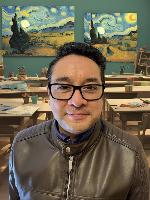Latin American Poets of the 20th Century Alive Through AI
,
Colorado Convention Center, Mile High Ballroom 3A
Presenters

Session description
Purpose & objective
The purpose of the presentation is for teachers of subjects such as Literature or Language Arts to know that it is possible to integrate AI into their classes to innovate.
The objective is for them to learn tools that make it possible for students to develop skills in story telling, reading comprehension and writing, and computational thinking.
Outline
We will use:
1. Playground AI to create an avatar from an original photograph of a 20th century poet.
2. Night Cafe to create a portrait using suitable prompts.
3. Studio D-id to make avatars and portraits talk.
In couples, participants will read a poem, imagine who it could have been dedicated to, and create a poetic response. They will create their character and have them recite their poem.
Those who like it will present their work and tell their experience while doing it and their feelings when finishing it.
Supporting research
Bramer, Max. (2009) Artificial intelligence: an international perspective. Berlin:
Springer Verlag.
Caicedo Bravo, Eduardo Francisco, y Jesús Alfonso López Sotelo. (2009) Una aproximación práctica a las redes neuronales artificiales. Colombia: Programa Editorial Universidad del Valle, (LIBRUNAM: QP363.3 C35).
García-Peñalvo, F. J., & Cruz-Benito, J. (2020). Inteligencia Artificial en Educación: Una Revisión Sistemática. LIBRUNAM.
Kumar, A., & Kumar, P. (2021). The Use of Artificial Intelligence (AI) in Education. Retrieved August 2023, from: https://research4committees.blog/2020/09/07/the-use-of-artificial-intelligence-ai-in-education/
UNESCO. (2020). Artificial Intelligence in Education. Retrieved August 2023, from: https://www.unesco.org/en/digital-education/artificial-intelligence
Session specifications
Laptop: PC, Chromebook, Mac
Tablet: Android, iOS, Windows
playgroundai.com free account.
Nightcafe.studio free account.
Lexica.art free account.
Studio.d-id.com free account.
Optional: vidnoz.com free account.
Leader
- Model for colleagues the identification, exploration, evaluation, curation and adoption of new digital resources and tools for learning.
- Design authentic learning activities that align with content area standards and use digital tools and resources to maximize active, deep learning.
- Manage the use of technology and student learning strategies in digital platforms, virtual environments, hands-on makerspaces or in the field.
 Return
Return Explore and create: Exploratory Creation lab
Explore and create: Exploratory Creation lab  Trips and Tours
Trips and Tours Preregistration Required
Preregistration Required